Asset Management Report: Water Infrastructure, System Engineering, LCC
VerifiedAdded on 2020/03/16
|9
|2797
|113
Report
AI Summary
This report delves into the critical aspects of asset management, focusing on water infrastructure and the enhancement of water pipeline lifespans. It emphasizes the significance of life cycle cost (LCC) analysis and system engineering as vital components of effective asset management. The report begins with an introduction to asset management, defining it as a systematic process encompassing acquisition, usage, maintenance, upgrades, and disposal of assets in a cost-effective manner. It then explores the application of system engineering and LCC analysis to optimize asset management outcomes. The literature review examines various studies, highlighting the benefits of incorporating LCC analysis into procurement processes, developing water system inventories, and utilizing LCC for environmentally friendly design strategies. The report also discusses the importance of classifying water assets and conducting system engineering studies for optimal resource utilization. The annotated bibliography provides a detailed analysis of a specific study on establishing an inventory for LCC analysis of a water supply system, evaluating its methodology, and assessing its alignment with ISO 55000 standards. Finally, the report addresses the cost implications of asset management after acquisition, emphasizing the impact on the overall life cycle cost analysis of the project, and concludes with recommendations for conducting effective LCC analysis.
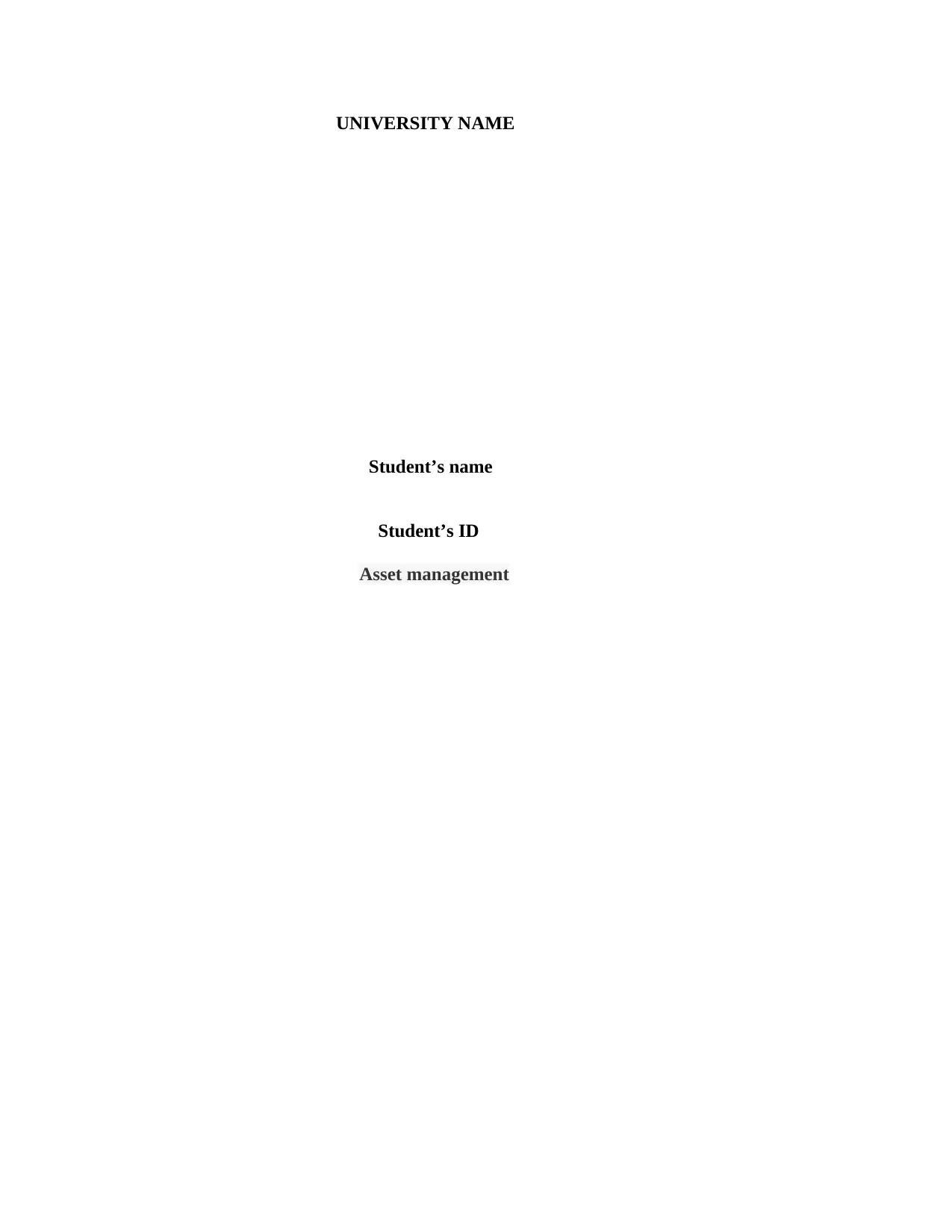
UNIVERSITY NAME
Student’s name
Student’s ID
Asset management
Student’s name
Student’s ID
Asset management
Paraphrase This Document
Need a fresh take? Get an instant paraphrase of this document with our AI Paraphraser
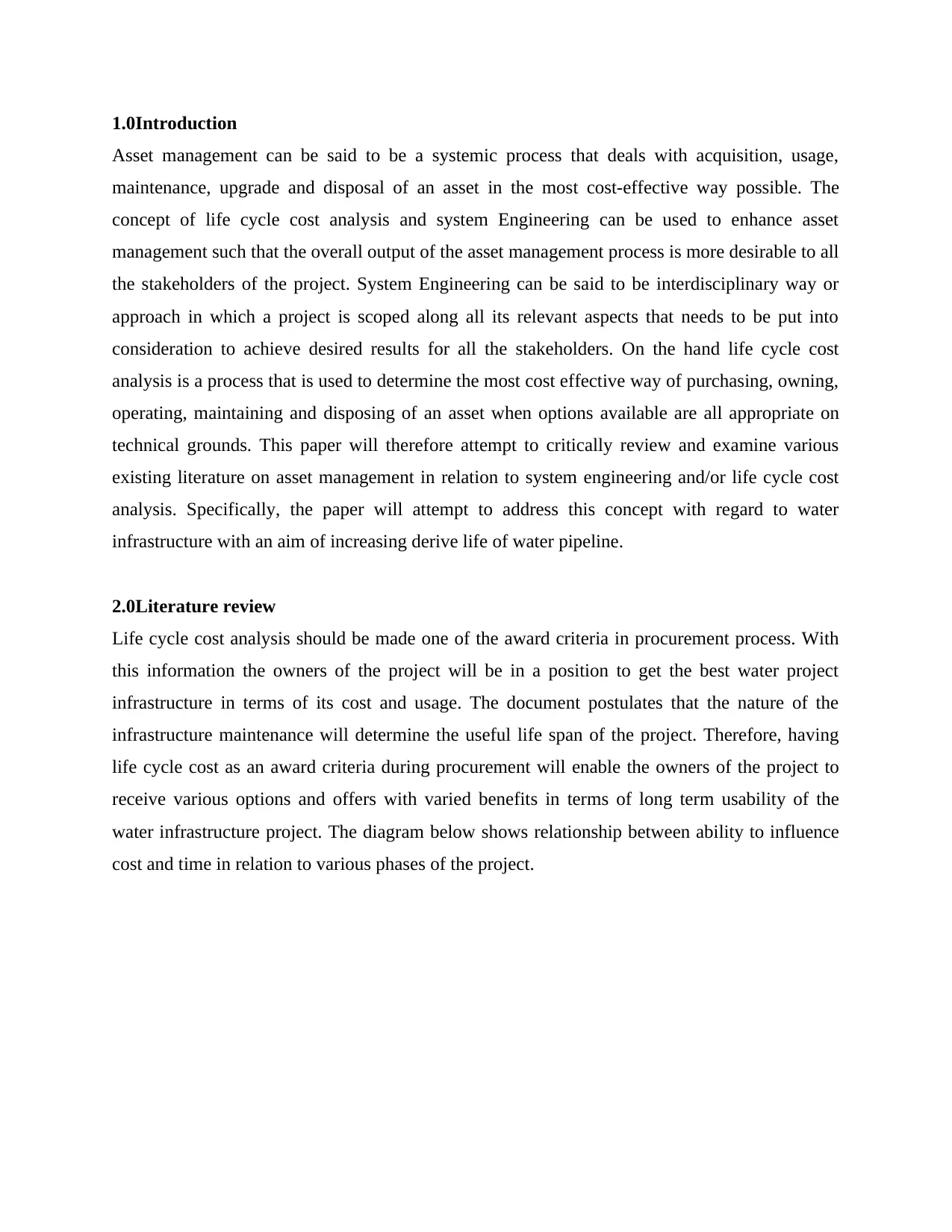
1.0Introduction
Asset management can be said to be a systemic process that deals with acquisition, usage,
maintenance, upgrade and disposal of an asset in the most cost-effective way possible. The
concept of life cycle cost analysis and system Engineering can be used to enhance asset
management such that the overall output of the asset management process is more desirable to all
the stakeholders of the project. System Engineering can be said to be interdisciplinary way or
approach in which a project is scoped along all its relevant aspects that needs to be put into
consideration to achieve desired results for all the stakeholders. On the hand life cycle cost
analysis is a process that is used to determine the most cost effective way of purchasing, owning,
operating, maintaining and disposing of an asset when options available are all appropriate on
technical grounds. This paper will therefore attempt to critically review and examine various
existing literature on asset management in relation to system engineering and/or life cycle cost
analysis. Specifically, the paper will attempt to address this concept with regard to water
infrastructure with an aim of increasing derive life of water pipeline.
2.0Literature review
Life cycle cost analysis should be made one of the award criteria in procurement process. With
this information the owners of the project will be in a position to get the best water project
infrastructure in terms of its cost and usage. The document postulates that the nature of the
infrastructure maintenance will determine the useful life span of the project. Therefore, having
life cycle cost as an award criteria during procurement will enable the owners of the project to
receive various options and offers with varied benefits in terms of long term usability of the
water infrastructure project. The diagram below shows relationship between ability to influence
cost and time in relation to various phases of the project.
Asset management can be said to be a systemic process that deals with acquisition, usage,
maintenance, upgrade and disposal of an asset in the most cost-effective way possible. The
concept of life cycle cost analysis and system Engineering can be used to enhance asset
management such that the overall output of the asset management process is more desirable to all
the stakeholders of the project. System Engineering can be said to be interdisciplinary way or
approach in which a project is scoped along all its relevant aspects that needs to be put into
consideration to achieve desired results for all the stakeholders. On the hand life cycle cost
analysis is a process that is used to determine the most cost effective way of purchasing, owning,
operating, maintaining and disposing of an asset when options available are all appropriate on
technical grounds. This paper will therefore attempt to critically review and examine various
existing literature on asset management in relation to system engineering and/or life cycle cost
analysis. Specifically, the paper will attempt to address this concept with regard to water
infrastructure with an aim of increasing derive life of water pipeline.
2.0Literature review
Life cycle cost analysis should be made one of the award criteria in procurement process. With
this information the owners of the project will be in a position to get the best water project
infrastructure in terms of its cost and usage. The document postulates that the nature of the
infrastructure maintenance will determine the useful life span of the project. Therefore, having
life cycle cost as an award criteria during procurement will enable the owners of the project to
receive various options and offers with varied benefits in terms of long term usability of the
water infrastructure project. The diagram below shows relationship between ability to influence
cost and time in relation to various phases of the project.

Ability to influence value
Life cycle cost not an award criterion
Life cycle cost an award criterion
Time
Optional analysis Permission Tender design tendering implementation
Conception plans., feasibility study
Fig 1.
From the figure 1 above, project cost will likely be low when LCC analysis is a requirement
during procurement. This will in turn enable the project owner have suitable options that when
implemented will see the water project infrastructure poses longer useful lifespan. (Alegre, 2009)
According to a study conducted on water system to provide water to the consumers in the most
stable way and also ensuring that the owners of the project meet their goals, an inventory of
water system was developed such that managers of the project will know when an item in the
system was due for replacement. This enabled the consumers to receive the commodity in a very
stable way and also assisting the company and/or managers to replace trouble making component
of the system before it affects the whole system of the water supply. The paper developed five
levels of water supply system inventory such that the higher the level, the more detailed facilities
were classified. (Lee et al., 2017)
To determine the most environmentally friendly design strategy of wastewater system for small
scales to medium scale usage; life cost analysis was carried out by composing an inventory of
materials and energy that would be required for the project. The study established various
variables regarding the consumption of water and linked it to environmental impact it could
Life cycle cost not an award criterion
Life cycle cost an award criterion
Time
Optional analysis Permission Tender design tendering implementation
Conception plans., feasibility study
Fig 1.
From the figure 1 above, project cost will likely be low when LCC analysis is a requirement
during procurement. This will in turn enable the project owner have suitable options that when
implemented will see the water project infrastructure poses longer useful lifespan. (Alegre, 2009)
According to a study conducted on water system to provide water to the consumers in the most
stable way and also ensuring that the owners of the project meet their goals, an inventory of
water system was developed such that managers of the project will know when an item in the
system was due for replacement. This enabled the consumers to receive the commodity in a very
stable way and also assisting the company and/or managers to replace trouble making component
of the system before it affects the whole system of the water supply. The paper developed five
levels of water supply system inventory such that the higher the level, the more detailed facilities
were classified. (Lee et al., 2017)
To determine the most environmentally friendly design strategy of wastewater system for small
scales to medium scale usage; life cost analysis was carried out by composing an inventory of
materials and energy that would be required for the project. The study established various
variables regarding the consumption of water and linked it to environmental impact it could
⊘ This is a preview!⊘
Do you want full access?
Subscribe today to unlock all pages.

Trusted by 1+ million students worldwide
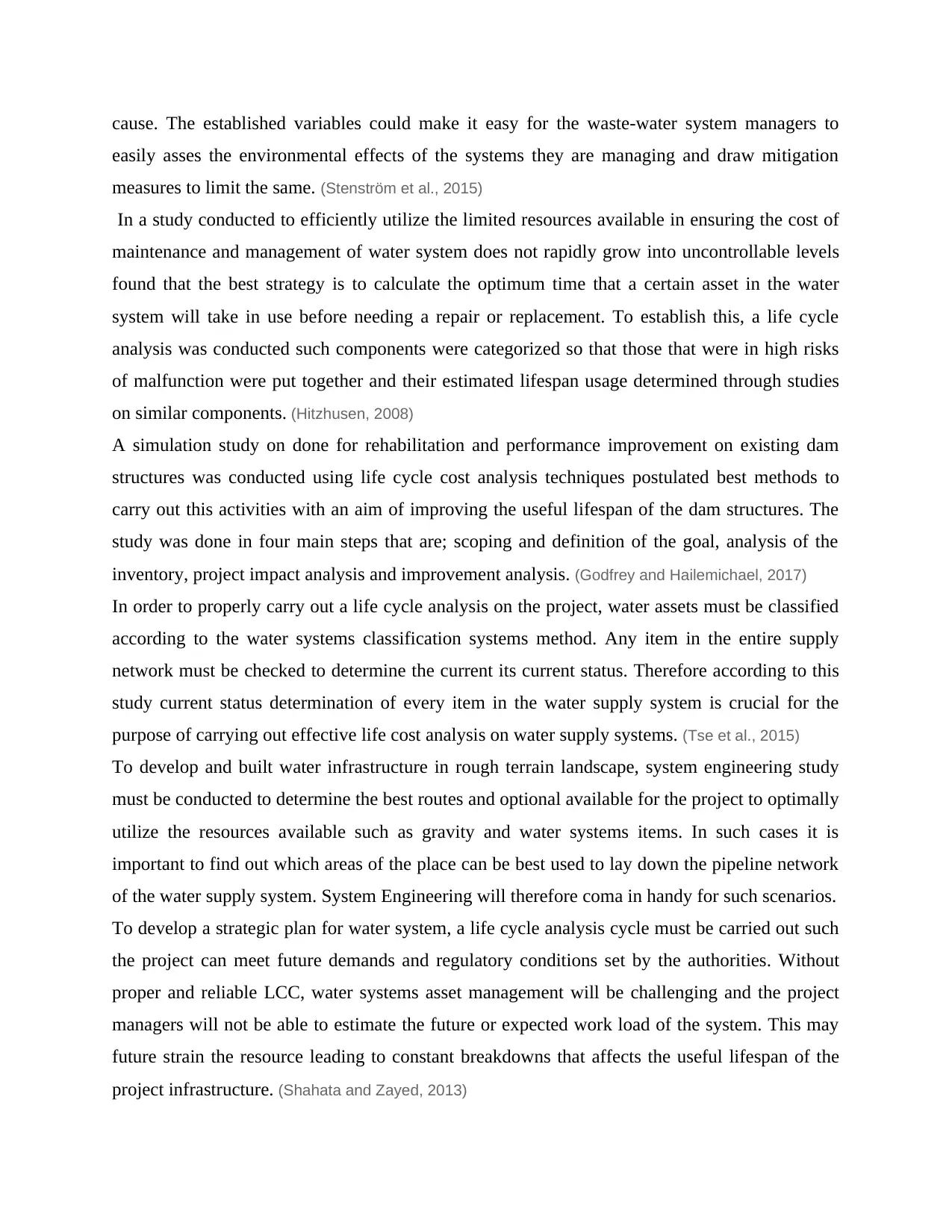
cause. The established variables could make it easy for the waste-water system managers to
easily asses the environmental effects of the systems they are managing and draw mitigation
measures to limit the same. (Stenström et al., 2015)
In a study conducted to efficiently utilize the limited resources available in ensuring the cost of
maintenance and management of water system does not rapidly grow into uncontrollable levels
found that the best strategy is to calculate the optimum time that a certain asset in the water
system will take in use before needing a repair or replacement. To establish this, a life cycle
analysis was conducted such components were categorized so that those that were in high risks
of malfunction were put together and their estimated lifespan usage determined through studies
on similar components. (Hitzhusen, 2008)
A simulation study on done for rehabilitation and performance improvement on existing dam
structures was conducted using life cycle cost analysis techniques postulated best methods to
carry out this activities with an aim of improving the useful lifespan of the dam structures. The
study was done in four main steps that are; scoping and definition of the goal, analysis of the
inventory, project impact analysis and improvement analysis. (Godfrey and Hailemichael, 2017)
In order to properly carry out a life cycle analysis on the project, water assets must be classified
according to the water systems classification systems method. Any item in the entire supply
network must be checked to determine the current its current status. Therefore according to this
study current status determination of every item in the water supply system is crucial for the
purpose of carrying out effective life cost analysis on water supply systems. (Tse et al., 2015)
To develop and built water infrastructure in rough terrain landscape, system engineering study
must be conducted to determine the best routes and optional available for the project to optimally
utilize the resources available such as gravity and water systems items. In such cases it is
important to find out which areas of the place can be best used to lay down the pipeline network
of the water supply system. System Engineering will therefore coma in handy for such scenarios.
To develop a strategic plan for water system, a life cycle analysis cycle must be carried out such
the project can meet future demands and regulatory conditions set by the authorities. Without
proper and reliable LCC, water systems asset management will be challenging and the project
managers will not be able to estimate the future or expected work load of the system. This may
future strain the resource leading to constant breakdowns that affects the useful lifespan of the
project infrastructure. (Shahata and Zayed, 2013)
easily asses the environmental effects of the systems they are managing and draw mitigation
measures to limit the same. (Stenström et al., 2015)
In a study conducted to efficiently utilize the limited resources available in ensuring the cost of
maintenance and management of water system does not rapidly grow into uncontrollable levels
found that the best strategy is to calculate the optimum time that a certain asset in the water
system will take in use before needing a repair or replacement. To establish this, a life cycle
analysis was conducted such components were categorized so that those that were in high risks
of malfunction were put together and their estimated lifespan usage determined through studies
on similar components. (Hitzhusen, 2008)
A simulation study on done for rehabilitation and performance improvement on existing dam
structures was conducted using life cycle cost analysis techniques postulated best methods to
carry out this activities with an aim of improving the useful lifespan of the dam structures. The
study was done in four main steps that are; scoping and definition of the goal, analysis of the
inventory, project impact analysis and improvement analysis. (Godfrey and Hailemichael, 2017)
In order to properly carry out a life cycle analysis on the project, water assets must be classified
according to the water systems classification systems method. Any item in the entire supply
network must be checked to determine the current its current status. Therefore according to this
study current status determination of every item in the water supply system is crucial for the
purpose of carrying out effective life cost analysis on water supply systems. (Tse et al., 2015)
To develop and built water infrastructure in rough terrain landscape, system engineering study
must be conducted to determine the best routes and optional available for the project to optimally
utilize the resources available such as gravity and water systems items. In such cases it is
important to find out which areas of the place can be best used to lay down the pipeline network
of the water supply system. System Engineering will therefore coma in handy for such scenarios.
To develop a strategic plan for water system, a life cycle analysis cycle must be carried out such
the project can meet future demands and regulatory conditions set by the authorities. Without
proper and reliable LCC, water systems asset management will be challenging and the project
managers will not be able to estimate the future or expected work load of the system. This may
future strain the resource leading to constant breakdowns that affects the useful lifespan of the
project infrastructure. (Shahata and Zayed, 2013)
Paraphrase This Document
Need a fresh take? Get an instant paraphrase of this document with our AI Paraphraser
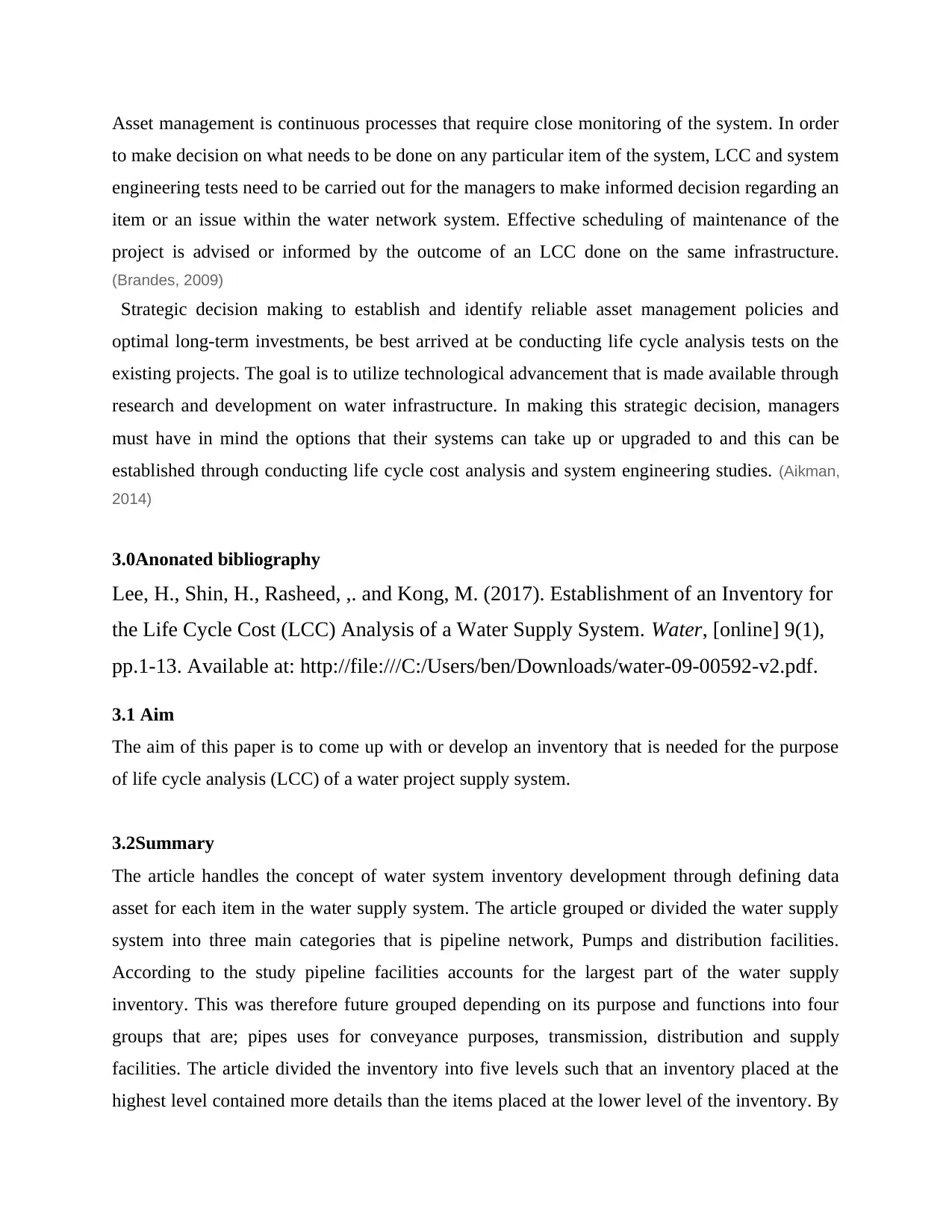
Asset management is continuous processes that require close monitoring of the system. In order
to make decision on what needs to be done on any particular item of the system, LCC and system
engineering tests need to be carried out for the managers to make informed decision regarding an
item or an issue within the water network system. Effective scheduling of maintenance of the
project is advised or informed by the outcome of an LCC done on the same infrastructure.
(Brandes, 2009)
Strategic decision making to establish and identify reliable asset management policies and
optimal long-term investments, be best arrived at be conducting life cycle analysis tests on the
existing projects. The goal is to utilize technological advancement that is made available through
research and development on water infrastructure. In making this strategic decision, managers
must have in mind the options that their systems can take up or upgraded to and this can be
established through conducting life cycle cost analysis and system engineering studies. (Aikman,
2014)
3.0Anonated bibliography
Lee, H., Shin, H., Rasheed, ,. and Kong, M. (2017). Establishment of an Inventory for
the Life Cycle Cost (LCC) Analysis of a Water Supply System. Water, [online] 9(1),
pp.1-13. Available at: http://file:///C:/Users/ben/Downloads/water-09-00592-v2.pdf.
3.1 Aim
The aim of this paper is to come up with or develop an inventory that is needed for the purpose
of life cycle analysis (LCC) of a water project supply system.
3.2Summary
The article handles the concept of water system inventory development through defining data
asset for each item in the water supply system. The article grouped or divided the water supply
system into three main categories that is pipeline network, Pumps and distribution facilities.
According to the study pipeline facilities accounts for the largest part of the water supply
inventory. This was therefore future grouped depending on its purpose and functions into four
groups that are; pipes uses for conveyance purposes, transmission, distribution and supply
facilities. The article divided the inventory into five levels such that an inventory placed at the
highest level contained more details than the items placed at the lower level of the inventory. By
to make decision on what needs to be done on any particular item of the system, LCC and system
engineering tests need to be carried out for the managers to make informed decision regarding an
item or an issue within the water network system. Effective scheduling of maintenance of the
project is advised or informed by the outcome of an LCC done on the same infrastructure.
(Brandes, 2009)
Strategic decision making to establish and identify reliable asset management policies and
optimal long-term investments, be best arrived at be conducting life cycle analysis tests on the
existing projects. The goal is to utilize technological advancement that is made available through
research and development on water infrastructure. In making this strategic decision, managers
must have in mind the options that their systems can take up or upgraded to and this can be
established through conducting life cycle cost analysis and system engineering studies. (Aikman,
2014)
3.0Anonated bibliography
Lee, H., Shin, H., Rasheed, ,. and Kong, M. (2017). Establishment of an Inventory for
the Life Cycle Cost (LCC) Analysis of a Water Supply System. Water, [online] 9(1),
pp.1-13. Available at: http://file:///C:/Users/ben/Downloads/water-09-00592-v2.pdf.
3.1 Aim
The aim of this paper is to come up with or develop an inventory that is needed for the purpose
of life cycle analysis (LCC) of a water project supply system.
3.2Summary
The article handles the concept of water system inventory development through defining data
asset for each item in the water supply system. The article grouped or divided the water supply
system into three main categories that is pipeline network, Pumps and distribution facilities.
According to the study pipeline facilities accounts for the largest part of the water supply
inventory. This was therefore future grouped depending on its purpose and functions into four
groups that are; pipes uses for conveyance purposes, transmission, distribution and supply
facilities. The article divided the inventory into five levels such that an inventory placed at the
highest level contained more details than the items placed at the lower level of the inventory. By
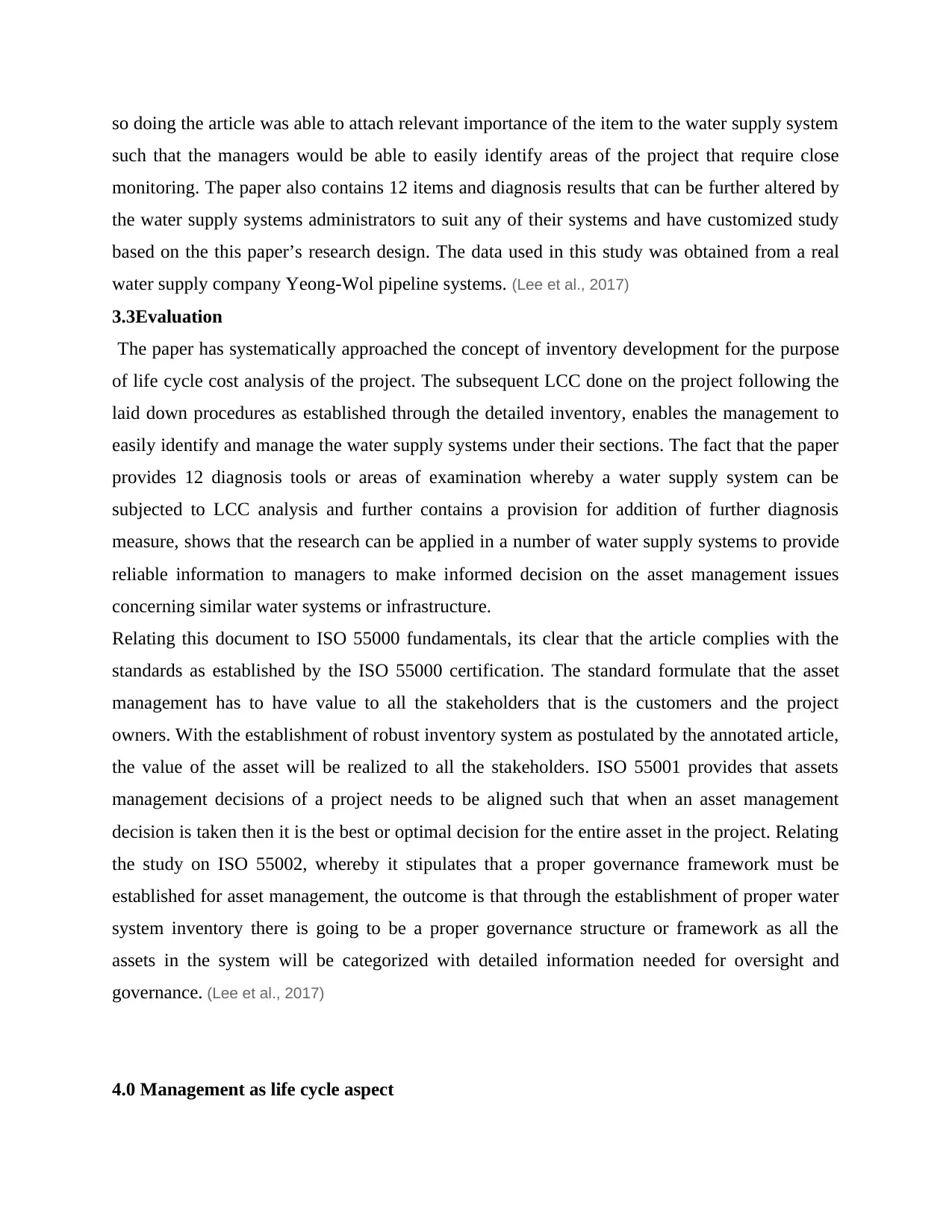
so doing the article was able to attach relevant importance of the item to the water supply system
such that the managers would be able to easily identify areas of the project that require close
monitoring. The paper also contains 12 items and diagnosis results that can be further altered by
the water supply systems administrators to suit any of their systems and have customized study
based on the this paper’s research design. The data used in this study was obtained from a real
water supply company Yeong-Wol pipeline systems. (Lee et al., 2017)
3.3Evaluation
The paper has systematically approached the concept of inventory development for the purpose
of life cycle cost analysis of the project. The subsequent LCC done on the project following the
laid down procedures as established through the detailed inventory, enables the management to
easily identify and manage the water supply systems under their sections. The fact that the paper
provides 12 diagnosis tools or areas of examination whereby a water supply system can be
subjected to LCC analysis and further contains a provision for addition of further diagnosis
measure, shows that the research can be applied in a number of water supply systems to provide
reliable information to managers to make informed decision on the asset management issues
concerning similar water systems or infrastructure.
Relating this document to ISO 55000 fundamentals, its clear that the article complies with the
standards as established by the ISO 55000 certification. The standard formulate that the asset
management has to have value to all the stakeholders that is the customers and the project
owners. With the establishment of robust inventory system as postulated by the annotated article,
the value of the asset will be realized to all the stakeholders. ISO 55001 provides that assets
management decisions of a project needs to be aligned such that when an asset management
decision is taken then it is the best or optimal decision for the entire asset in the project. Relating
the study on ISO 55002, whereby it stipulates that a proper governance framework must be
established for asset management, the outcome is that through the establishment of proper water
system inventory there is going to be a proper governance structure or framework as all the
assets in the system will be categorized with detailed information needed for oversight and
governance. (Lee et al., 2017)
4.0 Management as life cycle aspect
such that the managers would be able to easily identify areas of the project that require close
monitoring. The paper also contains 12 items and diagnosis results that can be further altered by
the water supply systems administrators to suit any of their systems and have customized study
based on the this paper’s research design. The data used in this study was obtained from a real
water supply company Yeong-Wol pipeline systems. (Lee et al., 2017)
3.3Evaluation
The paper has systematically approached the concept of inventory development for the purpose
of life cycle cost analysis of the project. The subsequent LCC done on the project following the
laid down procedures as established through the detailed inventory, enables the management to
easily identify and manage the water supply systems under their sections. The fact that the paper
provides 12 diagnosis tools or areas of examination whereby a water supply system can be
subjected to LCC analysis and further contains a provision for addition of further diagnosis
measure, shows that the research can be applied in a number of water supply systems to provide
reliable information to managers to make informed decision on the asset management issues
concerning similar water systems or infrastructure.
Relating this document to ISO 55000 fundamentals, its clear that the article complies with the
standards as established by the ISO 55000 certification. The standard formulate that the asset
management has to have value to all the stakeholders that is the customers and the project
owners. With the establishment of robust inventory system as postulated by the annotated article,
the value of the asset will be realized to all the stakeholders. ISO 55001 provides that assets
management decisions of a project needs to be aligned such that when an asset management
decision is taken then it is the best or optimal decision for the entire asset in the project. Relating
the study on ISO 55002, whereby it stipulates that a proper governance framework must be
established for asset management, the outcome is that through the establishment of proper water
system inventory there is going to be a proper governance structure or framework as all the
assets in the system will be categorized with detailed information needed for oversight and
governance. (Lee et al., 2017)
4.0 Management as life cycle aspect
⊘ This is a preview!⊘
Do you want full access?
Subscribe today to unlock all pages.

Trusted by 1+ million students worldwide

Management of the asset after acquisition has cost implication that affects life cycle cost
associated with the asset. Depending on the type of the asset, its management can be a high or
low. For example in water systems pumps require serving from time to time due to wear and tear
and also due to the load as a result of pumping water on continuous basis. Water supply systems
needs continuous investments depending on the change of demands such as growing market or
complying with a certain regulation brought in place by the authorities. There is also the need for
meeting varying customer’s demands and satisfaction that will necessitate investment in the
infrastructure to enhance or upgrade it to accommodate new requirements. After the acquisition
or installation of the project which has high initial cost, the cost of managing the project is the
next significant cost of the project. This cost however comes in trenches as it is spread across the
useful life time of the project. When this figure is calculated for a given considerable period of
time, the figure may be significant in comparison to the entire cost of the project. Therefore
managing the asset after acquisition has a substantial impact of the life cycle cost analysis of the
project. (Alegre, 2009)
5.0Reccomendation
In conducting life cycle analysis the cost drivers of the management part of the cycle should be
categorized such that those that require regular investments are grouped together while those that
need fewer repairs for instance are also grouped together. This will provide the management with
easier schedule and proper planning or scheduling of maintenance of the water project
infrastructure. The cost drivers can also be handled in such a way that for those delicate items in
the system a proper design or mechanism should be developed to minimize on their breakdown
and leads to repairs within short period of time.
6.0 References
associated with the asset. Depending on the type of the asset, its management can be a high or
low. For example in water systems pumps require serving from time to time due to wear and tear
and also due to the load as a result of pumping water on continuous basis. Water supply systems
needs continuous investments depending on the change of demands such as growing market or
complying with a certain regulation brought in place by the authorities. There is also the need for
meeting varying customer’s demands and satisfaction that will necessitate investment in the
infrastructure to enhance or upgrade it to accommodate new requirements. After the acquisition
or installation of the project which has high initial cost, the cost of managing the project is the
next significant cost of the project. This cost however comes in trenches as it is spread across the
useful life time of the project. When this figure is calculated for a given considerable period of
time, the figure may be significant in comparison to the entire cost of the project. Therefore
managing the asset after acquisition has a substantial impact of the life cycle cost analysis of the
project. (Alegre, 2009)
5.0Reccomendation
In conducting life cycle analysis the cost drivers of the management part of the cycle should be
categorized such that those that require regular investments are grouped together while those that
need fewer repairs for instance are also grouped together. This will provide the management with
easier schedule and proper planning or scheduling of maintenance of the water project
infrastructure. The cost drivers can also be handled in such a way that for those delicate items in
the system a proper design or mechanism should be developed to minimize on their breakdown
and leads to repairs within short period of time.
6.0 References
Paraphrase This Document
Need a fresh take? Get an instant paraphrase of this document with our AI Paraphraser
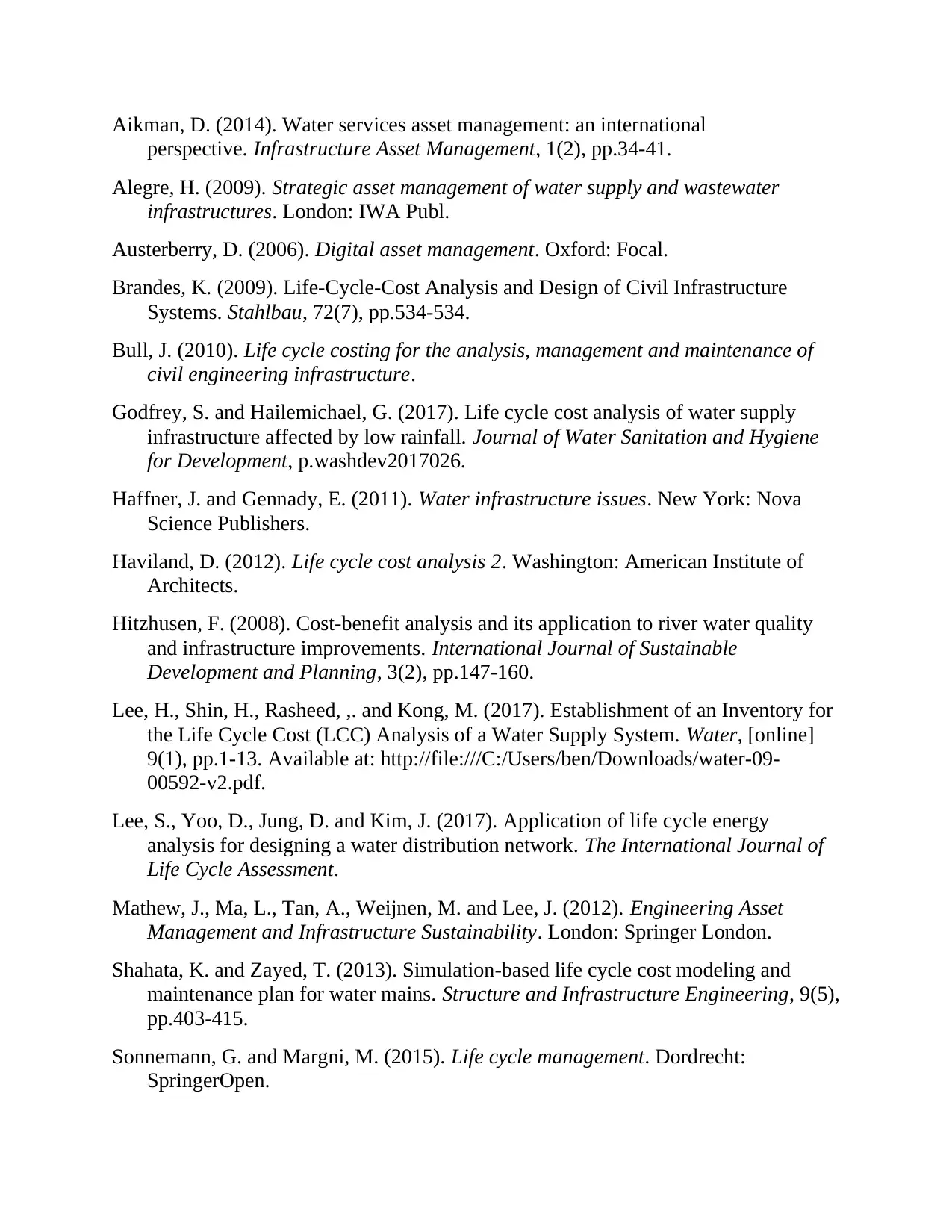
Aikman, D. (2014). Water services asset management: an international
perspective. Infrastructure Asset Management, 1(2), pp.34-41.
Alegre, H. (2009). Strategic asset management of water supply and wastewater
infrastructures. London: IWA Publ.
Austerberry, D. (2006). Digital asset management. Oxford: Focal.
Brandes, K. (2009). Life-Cycle-Cost Analysis and Design of Civil Infrastructure
Systems. Stahlbau, 72(7), pp.534-534.
Bull, J. (2010). Life cycle costing for the analysis, management and maintenance of
civil engineering infrastructure.
Godfrey, S. and Hailemichael, G. (2017). Life cycle cost analysis of water supply
infrastructure affected by low rainfall. Journal of Water Sanitation and Hygiene
for Development, p.washdev2017026.
Haffner, J. and Gennady, E. (2011). Water infrastructure issues. New York: Nova
Science Publishers.
Haviland, D. (2012). Life cycle cost analysis 2. Washington: American Institute of
Architects.
Hitzhusen, F. (2008). Cost-benefit analysis and its application to river water quality
and infrastructure improvements. International Journal of Sustainable
Development and Planning, 3(2), pp.147-160.
Lee, H., Shin, H., Rasheed, ,. and Kong, M. (2017). Establishment of an Inventory for
the Life Cycle Cost (LCC) Analysis of a Water Supply System. Water, [online]
9(1), pp.1-13. Available at: http://file:///C:/Users/ben/Downloads/water-09-
00592-v2.pdf.
Lee, S., Yoo, D., Jung, D. and Kim, J. (2017). Application of life cycle energy
analysis for designing a water distribution network. The International Journal of
Life Cycle Assessment.
Mathew, J., Ma, L., Tan, A., Weijnen, M. and Lee, J. (2012). Engineering Asset
Management and Infrastructure Sustainability. London: Springer London.
Shahata, K. and Zayed, T. (2013). Simulation-based life cycle cost modeling and
maintenance plan for water mains. Structure and Infrastructure Engineering, 9(5),
pp.403-415.
Sonnemann, G. and Margni, M. (2015). Life cycle management. Dordrecht:
SpringerOpen.
perspective. Infrastructure Asset Management, 1(2), pp.34-41.
Alegre, H. (2009). Strategic asset management of water supply and wastewater
infrastructures. London: IWA Publ.
Austerberry, D. (2006). Digital asset management. Oxford: Focal.
Brandes, K. (2009). Life-Cycle-Cost Analysis and Design of Civil Infrastructure
Systems. Stahlbau, 72(7), pp.534-534.
Bull, J. (2010). Life cycle costing for the analysis, management and maintenance of
civil engineering infrastructure.
Godfrey, S. and Hailemichael, G. (2017). Life cycle cost analysis of water supply
infrastructure affected by low rainfall. Journal of Water Sanitation and Hygiene
for Development, p.washdev2017026.
Haffner, J. and Gennady, E. (2011). Water infrastructure issues. New York: Nova
Science Publishers.
Haviland, D. (2012). Life cycle cost analysis 2. Washington: American Institute of
Architects.
Hitzhusen, F. (2008). Cost-benefit analysis and its application to river water quality
and infrastructure improvements. International Journal of Sustainable
Development and Planning, 3(2), pp.147-160.
Lee, H., Shin, H., Rasheed, ,. and Kong, M. (2017). Establishment of an Inventory for
the Life Cycle Cost (LCC) Analysis of a Water Supply System. Water, [online]
9(1), pp.1-13. Available at: http://file:///C:/Users/ben/Downloads/water-09-
00592-v2.pdf.
Lee, S., Yoo, D., Jung, D. and Kim, J. (2017). Application of life cycle energy
analysis for designing a water distribution network. The International Journal of
Life Cycle Assessment.
Mathew, J., Ma, L., Tan, A., Weijnen, M. and Lee, J. (2012). Engineering Asset
Management and Infrastructure Sustainability. London: Springer London.
Shahata, K. and Zayed, T. (2013). Simulation-based life cycle cost modeling and
maintenance plan for water mains. Structure and Infrastructure Engineering, 9(5),
pp.403-415.
Sonnemann, G. and Margni, M. (2015). Life cycle management. Dordrecht:
SpringerOpen.
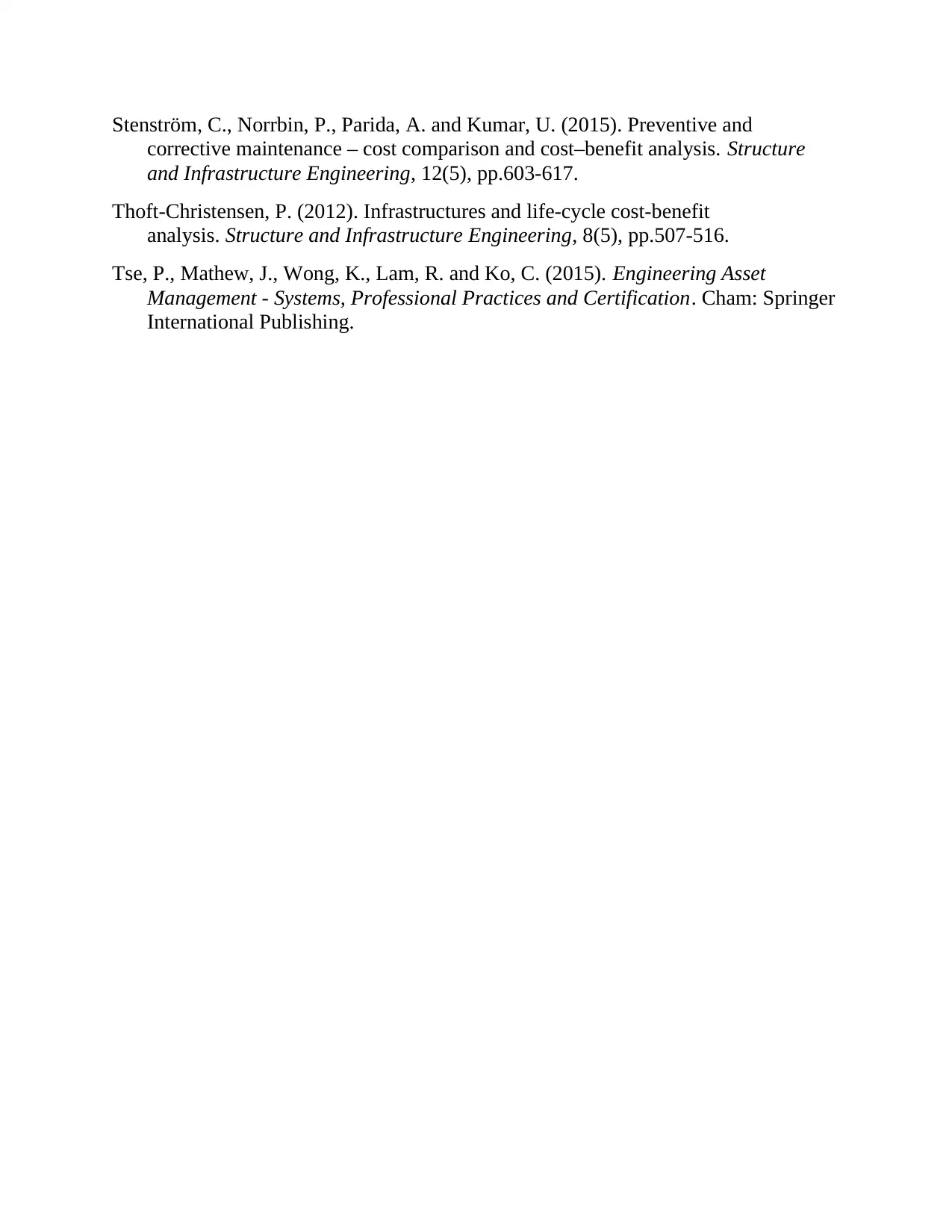
Stenström, C., Norrbin, P., Parida, A. and Kumar, U. (2015). Preventive and
corrective maintenance – cost comparison and cost–benefit analysis. Structure
and Infrastructure Engineering, 12(5), pp.603-617.
Thoft-Christensen, P. (2012). Infrastructures and life-cycle cost-benefit
analysis. Structure and Infrastructure Engineering, 8(5), pp.507-516.
Tse, P., Mathew, J., Wong, K., Lam, R. and Ko, C. (2015). Engineering Asset
Management - Systems, Professional Practices and Certification. Cham: Springer
International Publishing.
corrective maintenance – cost comparison and cost–benefit analysis. Structure
and Infrastructure Engineering, 12(5), pp.603-617.
Thoft-Christensen, P. (2012). Infrastructures and life-cycle cost-benefit
analysis. Structure and Infrastructure Engineering, 8(5), pp.507-516.
Tse, P., Mathew, J., Wong, K., Lam, R. and Ko, C. (2015). Engineering Asset
Management - Systems, Professional Practices and Certification. Cham: Springer
International Publishing.
⊘ This is a preview!⊘
Do you want full access?
Subscribe today to unlock all pages.

Trusted by 1+ million students worldwide
1 out of 9
Related Documents
Your All-in-One AI-Powered Toolkit for Academic Success.
+13062052269
info@desklib.com
Available 24*7 on WhatsApp / Email
![[object Object]](/_next/static/media/star-bottom.7253800d.svg)
Unlock your academic potential
Copyright © 2020–2025 A2Z Services. All Rights Reserved. Developed and managed by ZUCOL.




